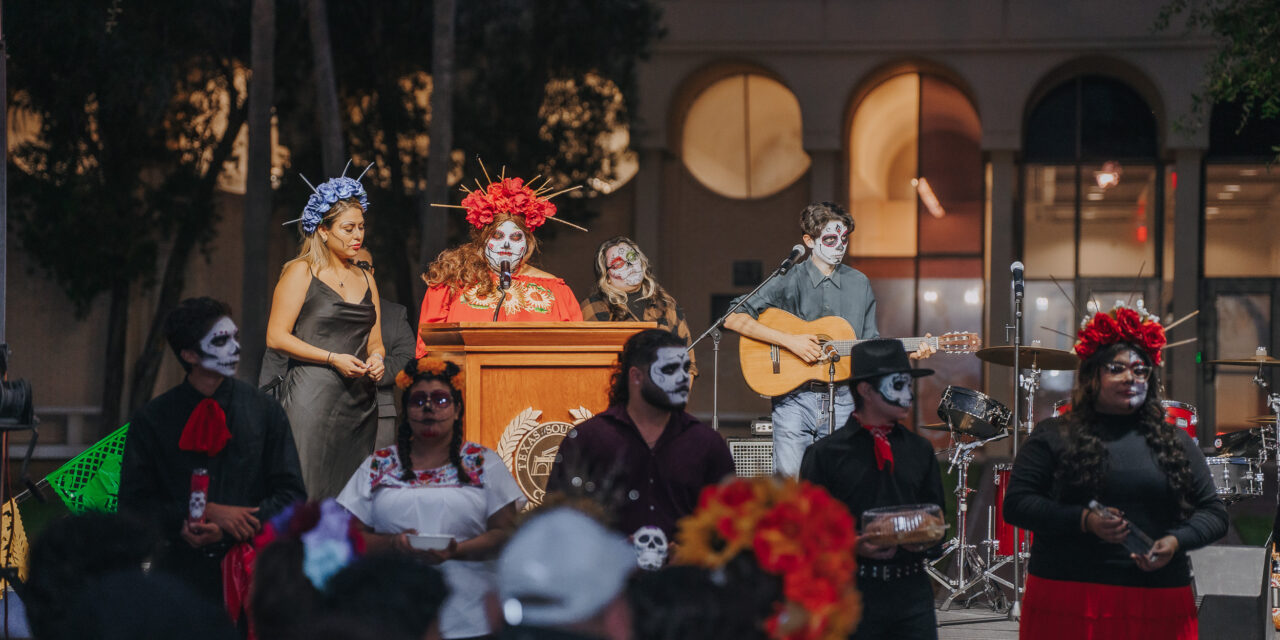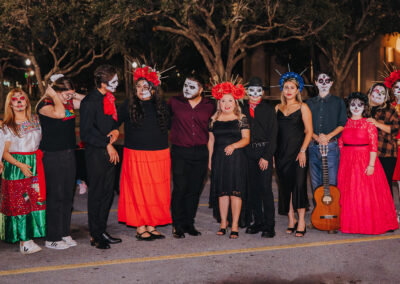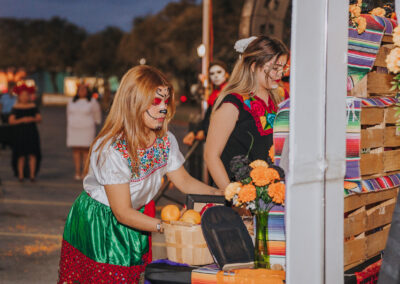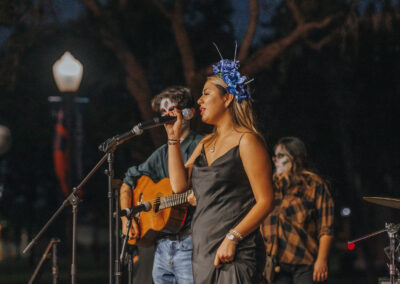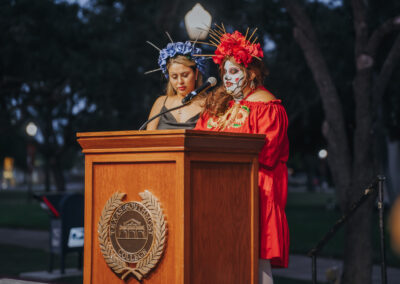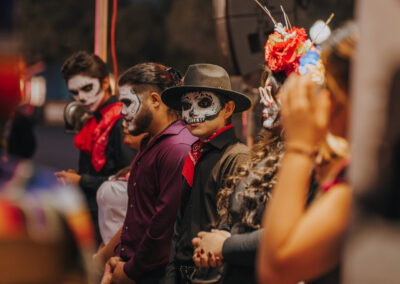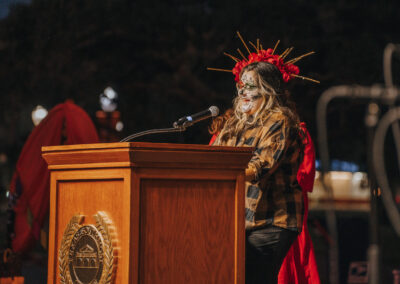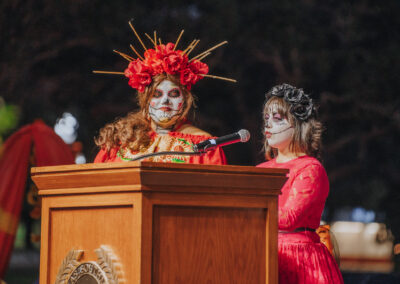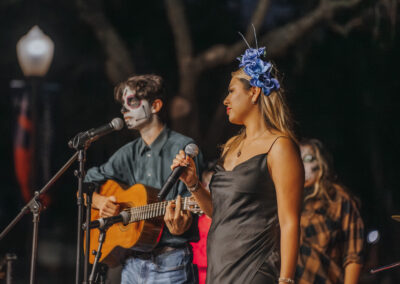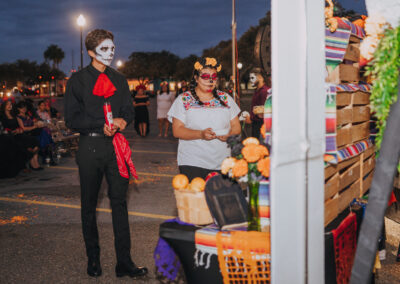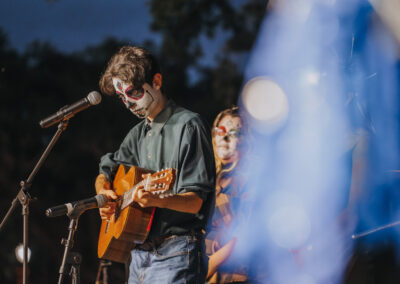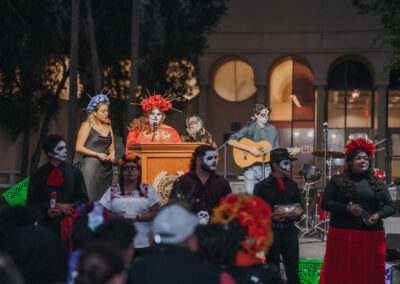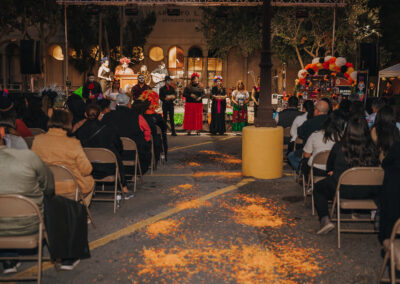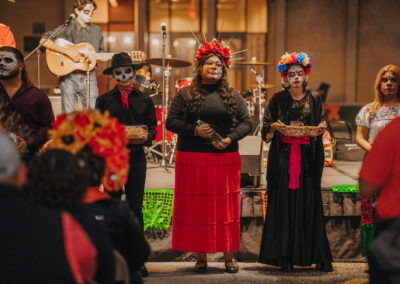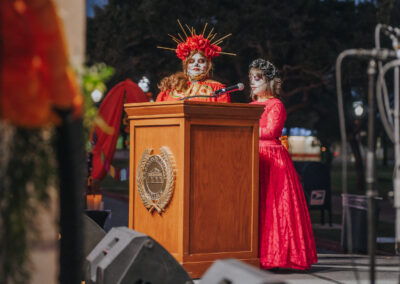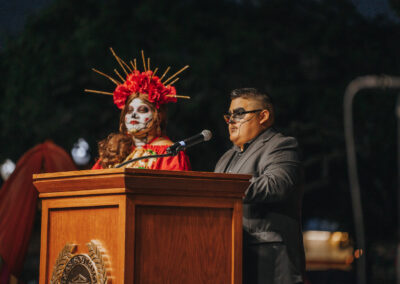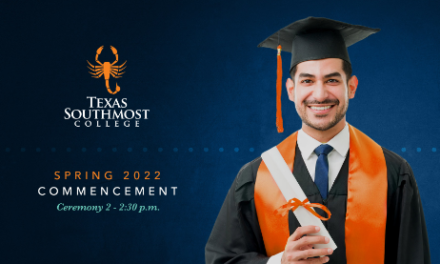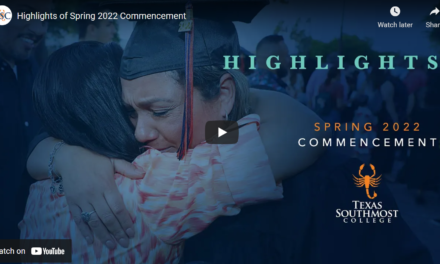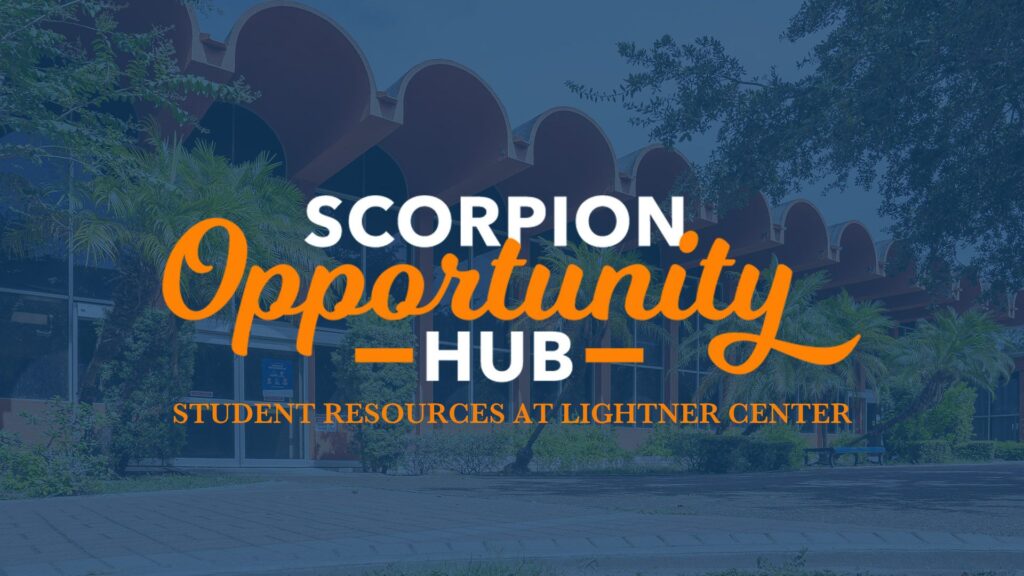In a celebration of cultural richness and diversity, students of the Mexican American class at Texas Southmost College, led by History Instructor Gina Silva, recently captivated audiences with their insightful and heartfelt presentation on the history of Dia de los Muertos. The event showcased their academic prowess and commitment to preserving and sharing the vibrant traditions of the Mexican culture.
The passionate and dedicated students delved into the rich history of Dia de los Muertos, unraveling its origins and evolution. With eloquence and enthusiasm, they painted a vivid picture of how this Mexican holiday, also known as the Day of the Dead, has transcended time and borders, becoming a beloved tradition celebrated in Mexico and worldwide.
One of the presentation’s highlights was exploring the significance of altars in Dia de los Muertos celebrations. The students beautifully articulated how these elaborate displays serve as poignant tributes to departed loved ones, combining elements of indigenous beliefs with Catholic traditions. Through their research and presentation, they shed light on the symbolism behind each component of the altar, from the vibrant marigolds to the favorite foods and cherished photographs.
The event wasn’t just a history lesson but a celebration of cultural identity and heritage. The students’ passion for their roots shone through as they spoke about preserving and passing down traditions from one generation to the next. Their dedication to promoting cultural understanding and appreciation was evident in every word spoken, creating a tapestry of unity and respect.
The Texas Southmost College Mexican American class continued beyond a classroom presentation. They actively engaged with the community, inviting residents to participate in the festivities and learn more about Dia de los Muertos. This outreach initiative fostered a sense of community and created an open space for cultural exchange, fostering understanding and mutual respect.
As we congratulate the students of the Texas Southmost College Mexican American class, we also commend them for their commitment to education, cultural preservation, and community engagement. Their presentation on Dia de los Muertos was not just an academic exercise but a heartfelt tribute to the resilience and beauty of Mexican traditions. In celebrating Dia de los Muertos, they have enriched their lives and contributed to the cultural mosaic that makes our community diverse and vibrant.
We look forward to more inspiring initiatives from these dedicated students and the continued celebration of our shared cultural heritage.
The students responsible for providing a concise history of Dia de los Muertos, elucidating the altar components, delivering poems, and performing a song are students in Ms. Gina Silva’s Mexican American History Class. The following passages were presented at Texas Southmost College’s recent Dia De Los Muertos Celebration. It explains the history and the various components of the celebration.
Dia De De Los Muertos History
Day of the Dead is a Mexican holiday with deep roots in indigenous traditions, such as the Aztec and Maya civilizations. It is a time to honor and remember deceased loved ones. The holiday typically lasts from October 31 to November 2.
The origins of the Day of the Dead can be traced back to ancient Mesoamerican beliefs, where it was dedicated to the goddess Mictecacihuatl. After the Spanish colonization, it blended with Catholic All Saints’ and All Souls’ Days. Families build ofrendas (altars) adorned with marigolds, sugar skulls, and the departed’s favorite foods. They visit gravesites, clean, decorate them, and share stories about their loved ones. This unique celebration blends indigenous and European influences, creating a vibrant and meaningful commemoration of those who have passed away.
We celebrate Dia de Muertos, or Day of the Dead, to honor and remember our loved ones who have passed away. It is a time to create ofrendas, or altars, filled with their favorite items and to offer marigold flowers and sugar skulls as gifts. This tradition allows us to keep our ancestors’ memory alive and believe that their spirits return to be with us during this special time.
Altar levels- The top level represents the sky and is usually adorned with religious symbols, candles, and images of saints. The middle level is meant to symbolize the earthly realm and typically includes items that the deceased person enjoyed in life, such as their favorite foods, drinks, and personal mementos. The bottom level signifies the underworld or the afterlife. It is often decorated with items like sugar skulls, marigold flowers, and other traditional Day of the Dead offerings.
Salt- Salt is typically placed on the ofrenda to represent the purification of the souls of the departed. It is believed to help the souls of the deceased find their way to the ofrenda and to provide them with sustenance during their spiritual journey.
Marigold- The Marigold is believed to help attract the souls with its smell and guide the souls back to the altar, leading them to be able to rest after a long day crossing to the land of the living.
Papel Picado- The Papel Picado symbolizes the union between life and death; not only that, but it also shows the joy in life.
The candle welcomes the spirits back to the altar, and the copal keeps the evil spirits and energy away while guiding the souls to the altar.
The skull symbolizes the people who have passed and will be receiving the gifts, while the sugar represents the sweetness in life.
The Pan de Muerto symbolizes the circle of Life and Death, the ball in the center represents the skull of the deceased, and the pieces that form a cross signify the bones and tears. The bread is placed on the altar so the souls that come to visit will have something to eat. The Water is to clench the thirsts of the souls coming to the land of the living.
The ofrendas are the gifts and offerings we give to those who are deceased to honor and remember. It is a way to welcome their spirits back to the land of the Living and celebrate their lives.
The photographs are placed on the altar last. It is believed that the photo will bring the souls back to the Land of the Living, and begin to draw them to the altar, if the photos aren’t put up, they won’t be able to cross to the Land of the Living.
A big shout-out is extended to the students who collaborated with TSC Student Life to orchestrate a triumphant Dia De Los Muertos celebration at Texas Southmost College.
Citlaly Lopez, Jesus Cortinas, Michelle Tovar, Daniel Ramirez, Israel Balli, Angelica Cervantes, Cristina Gonzalez, Cristina Gonzalez, Vanette Murillo, Yuliana Ramirez, Sayra Matu, Maria Avendado, Nayeli Pena and Miguel Salcido.
Texas Southmost College hosts annual Día de los Muertos Celebration
Texas Southmost College hosted its annual Día de los Muertos Celebration on November 2, 2023 to cherish the memories of our dearly departed and come together to celebrate our local culture and strengthen the bonds that unite us.
Texas Southmost College hosts annual Día de los Muertos Celebration
Texas Southmost College hosted its annual Día de los Muertos Celebration on November 2, 2023 to cherish the memories of our dearly departed and come together to celebrate our local culture and strengthen the bonds that unite us.
Texas Southmost College hosts annual Día de los Muertos Celebration
Texas Southmost College hosted its annual Día de los Muertos Celebration on November 2, 2023 to cherish the memories of our dearly departed and come together to celebrate our local culture and strengthen the bonds that unite us.
Texas Southmost College hosts annual Día de los Muertos Celebration
Texas Southmost College hosted its annual Día de los Muertos Celebration on November 2, 2023 to cherish the memories of our dearly departed and come together to celebrate our local culture and strengthen the bonds that unite us.
Texas Southmost College hosts annual Día de los Muertos Celebration
Texas Southmost College hosted its annual Día de los Muertos Celebration on November 2, 2023 to cherish the memories of our dearly departed and come together to celebrate our local culture and strengthen the bonds that unite us.
Texas Southmost College hosts annual Día de los Muertos Celebration
Texas Southmost College hosted its annual Día de los Muertos Celebration on November 2, 2023 to cherish the memories of our dearly departed and come together to celebrate our local culture and strengthen the bonds that unite us.
Texas Southmost College hosts annual Día de los Muertos Celebration
Texas Southmost College hosted its annual Día de los Muertos Celebration on November 2, 2023 to cherish the memories of our dearly departed and come together to celebrate our local culture and strengthen the bonds that unite us.
Texas Southmost College hosts annual Día de los Muertos Celebration
Texas Southmost College hosted its annual Día de los Muertos Celebration on November 2, 2023 to cherish the memories of our dearly departed and come together to celebrate our local culture and strengthen the bonds that unite us.
Texas Southmost College hosts annual Día de los Muertos Celebra
Texas Southmost College hosted its annual Día de los Muertos Celebration on November 2, 2023 to cherish the memories of our dearly departed and come together to celebrate our local culture and strengthen the bonds that unite us.
Texas Southmost College hosts annual Día de los Muertos Celebration
Texas Southmost College hosted its annual Día de los Muertos Celebration on November 2, 2023 to cherish the memories of our dearly departed and come together to celebrate our local culture and strengthen the bonds that unite us.
Texas Southmost College hosts annual Día de los Muertos Celebration
Texas Southmost College hosted its annual Día de los Muertos Celebration on November 2, 2023 to cherish the memories of our dearly departed and come together to celebrate our local culture and strengthen the bonds that unite us.
Texas Southmost College hosts annual Día de los Muertos Celebration
Texas Southmost College hosted its annual Día de los Muertos Celebration on November 2, 2023 to cherish the memories of our dearly departed and come together to celebrate our local culture and strengthen the bonds that unite us.
